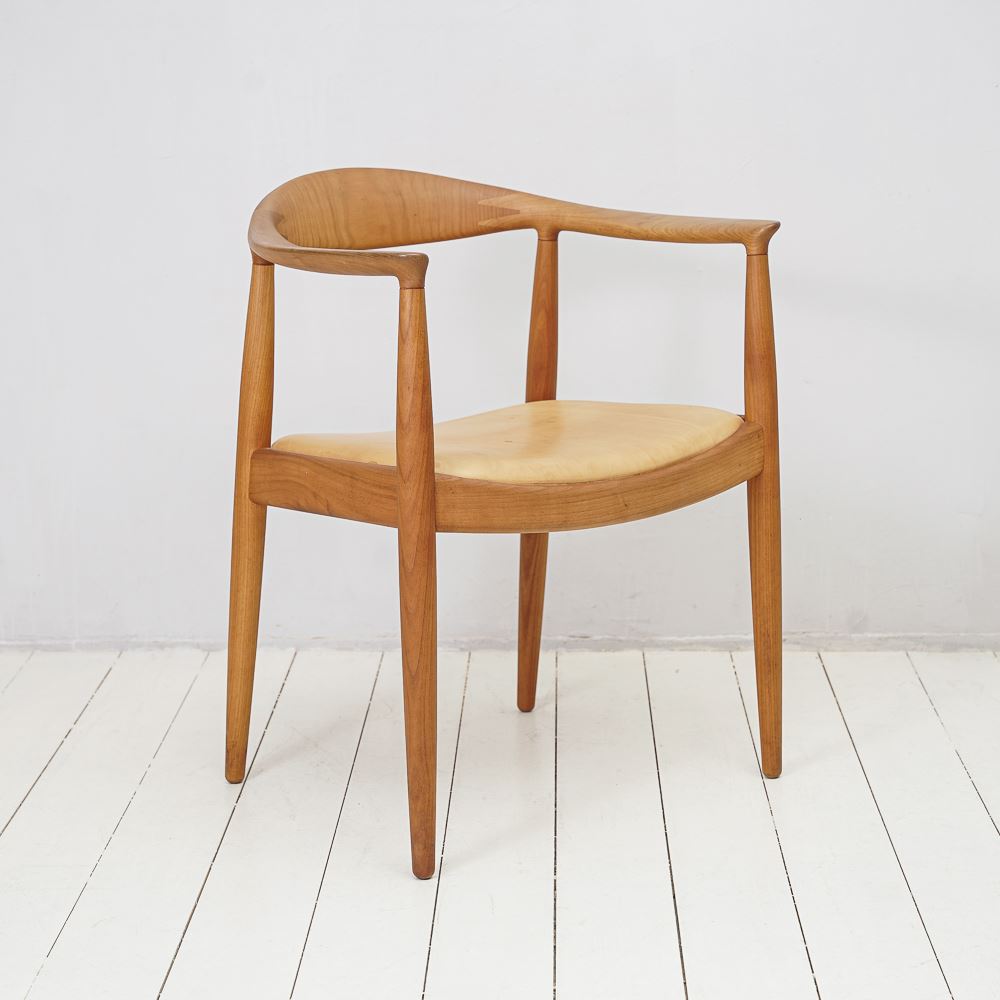
PP503圓椅
設計師 | 漢斯·韋格納 (丹麥)
設計時間 | 1949
品牌 | PP家具廠 (丹麥)
規格 | 寬63 x 深52 x 高75公分
材質 | 櫻桃木.皮革
PP503, The Chair
DESIGNER.Hans J. Wegner (Denmark)
DESIGNED.1949
MANUFACTURER.PP Møbler (Denmark)
DIMENSIONS.W63 x D52 x H75cm
MATERIALS.Cherry, leather
丹麥家具設計師漢斯·韋格納(Hans Wegner)的作品深受中國明式家具的影響,特別是簡練的結構與彎曲扶手的優雅線條,更直接體現在韋格納的作品中,如:1943年的中國椅(PP56, The Chinese Chair)、1949年的Y字椅(CH24, Y Chair)。韋格納最具標誌性的作品是1949年,被世人稱為「The Chair」的圓椅,是最具代表的經典之作。
這件作品首次亮相於1949年丹麥哥本哈根匠師公會(丹麥文Københavns Snedkerlaug)展覽,由家具廠約翰內斯·漢森(Johannes Hansen)展示藤椅面版本的JH501;1950年又推出了皮革椅面的JH503。同年2月,JH501在美國《Interiors》雜誌獲得全頁介紹,並帶來了大量的訂單,成為丹麥家具進軍國際市場的重要關鍵。
JH501最初設計時,由於椅背及扶手是由三段木材組合而成,連接處木紋無法連貫,因此椅背以藤皮纏繞包覆的方式修飾;1950年推出的JH503改使用W型接榫設計,不僅增加膠合面積,結構更加穩固外,也美化了木紋不連貫的問題。JH501藤纏背的版本持續生產至60年代,家具廠約翰內斯.漢森於90年代初結束經營,韋格納將The Chair的生產交由PP家具廠(PP Møbler)延續。
在美學上,「The Chair」是一種對傳統的創新,形式上可追溯至中國明式家具的影響,但韋格納去除多餘裝飾,突出結構美感,源於傳統而有所創新。
PP503圓椅由12個組件組成,做工精緻從各個角度欣賞皆呈現線條流暢的視覺效果,尤其椅背與扶手的轉折尤為優美,完美展現韋格納的設計理念:“Et stykke møbel må aldrig have en bagside, det hele skal hænge sammen.”(一件家具不應該有背面,整體必須和諧連貫)。功能上,椅背的曲度提供良好支撐,兩側延伸至前端的扶手增加了包覆性與穩定性,讓這張椅子具備超凡的舒適感,廣受讚譽。
「The Chair」在許多重要場合中曾被使用,如:1960年美國總統電視辯論會上,候選人尼克森(Richard M. Nixon)與甘迺迪(John F. Kennedy)所坐的椅子就是JH503;2009年哥本哈根聯合國氣候變遷會議,各國元首的座椅也同樣選用了這款經典之作(PP503)。
Danish furniture designer Hans Wegner was deeply influenced by Chinese Ming Dynasty furniture, particularly the refined structure and elegant curved armrests. This influence is directly reflected in Wegner’s designs, such as the 1943 Chinese Chair (PP56) and the 1949 Y Chair (CH24). Wegner's most iconic work is the Round Chair, often referred to simply as ""The Chair,"" introduced in 1949 and celebrated as a classic masterpiece.
The Round Chair debuted in 1949 at the Copenhagen Cabinetmakers’ Guild (Københavns Snedkerlaug) exhibition, where furniture manufacturer Johannes Hansen presented the rattan seat version, JH501. In 1950, a leather seat version, JH503, was introduced. That same year, JH501 received a full-page feature in the American magazine Interiors, resulting in a surge of orders and marking a pivotal moment for Danish furniture’s entry into the international market.
In the original JH501 design, the backrest and armrest were crafted from three separate wood pieces, with visible joints where the wood grain did not align. To address this, the backrest was wrapped in rattan for a seamless look. The 1950 JH503 model introduced a W-shaped joint, increasing the glued surface area for enhanced stability and resolving the wood grain alignment issue. Production of the JH501 rattan version continued until the 1960s, and after Johannes Hansen’s company closed in the early 1990s, production of The Chair was passed on to PP Møbler.
Aesthetically, The Chair represents an innovative take on tradition. While its form is inspired by Ming Dynasty furniture, Wegner removed any unnecessary ornamentation to emphasize structural beauty, making it a harmonious blend of tradition and innovation.
The PP503 Round Chair comprises 12 components, each crafted with precision to create a visually harmonious effect from every angle. The elegant transitions between the backrest and armrests exemplify Wegner’s design philosophy: “Et stykke møbel må aldrig have en bagside, det hele skal hænge sammen” (“A piece of furniture should never have a backside; the whole must be harmonious and complete”). Functionally, the curve of the backrest provides excellent support, and the armrests, which extend forward, add stability and a sense of enclosure, making this chair exceptionally comfortable and highly acclaimed.
The Chair has been used in numerous significant events. For example, it was the seat chosen for the candidates Nixon and Kennedy during the 1960 U.S. presidential television debate, and in 2009, it served as the chair for world leaders at the United Nations Climate Change Conference in Copenhagen (PP503)."